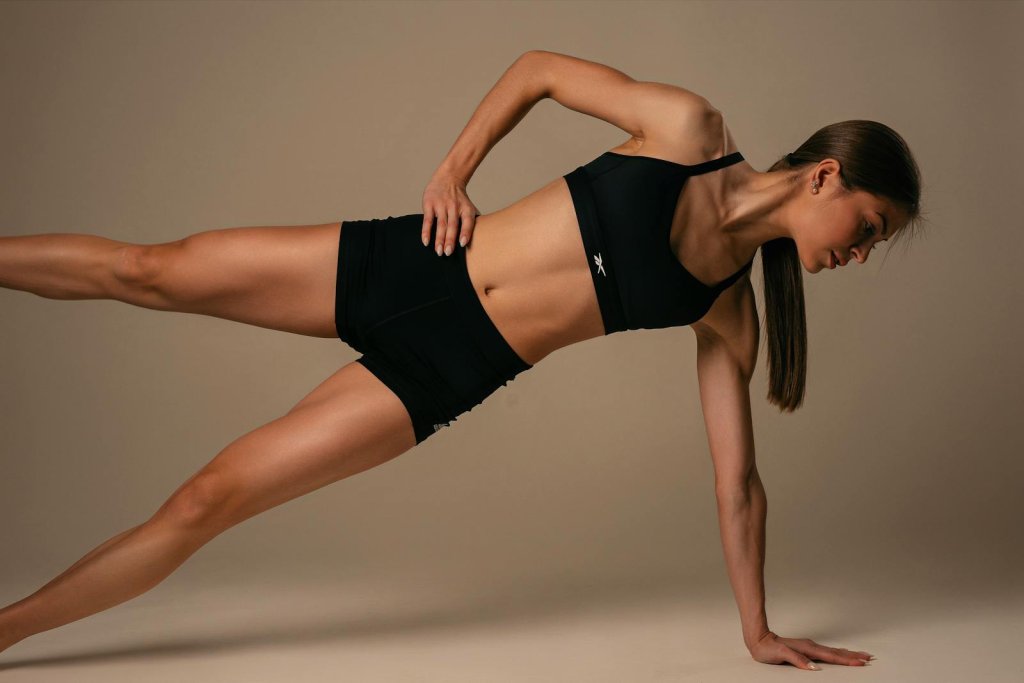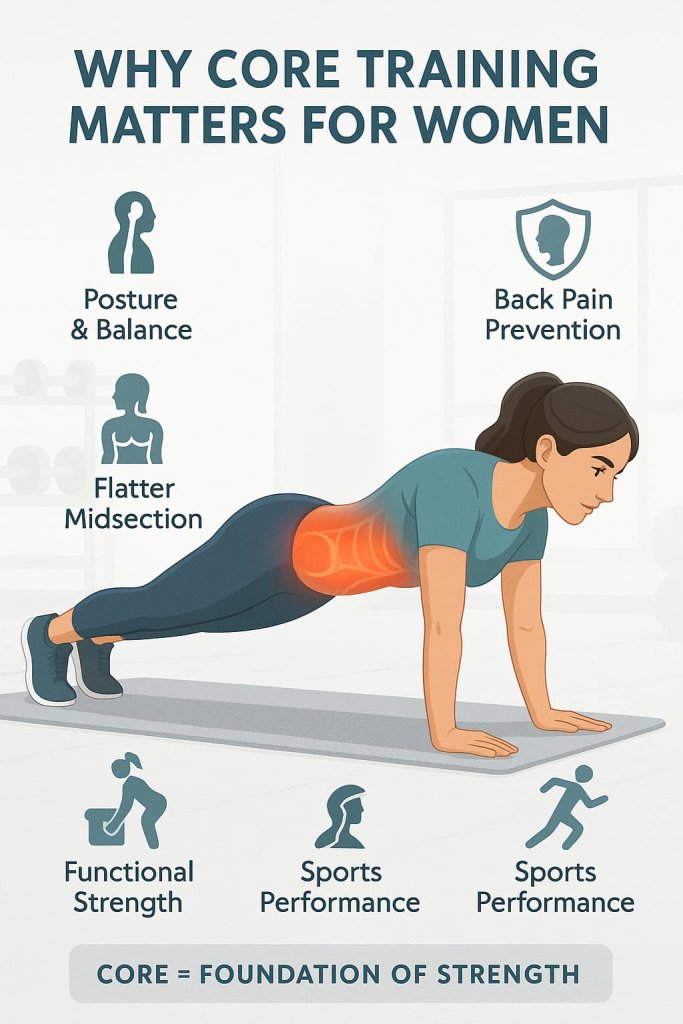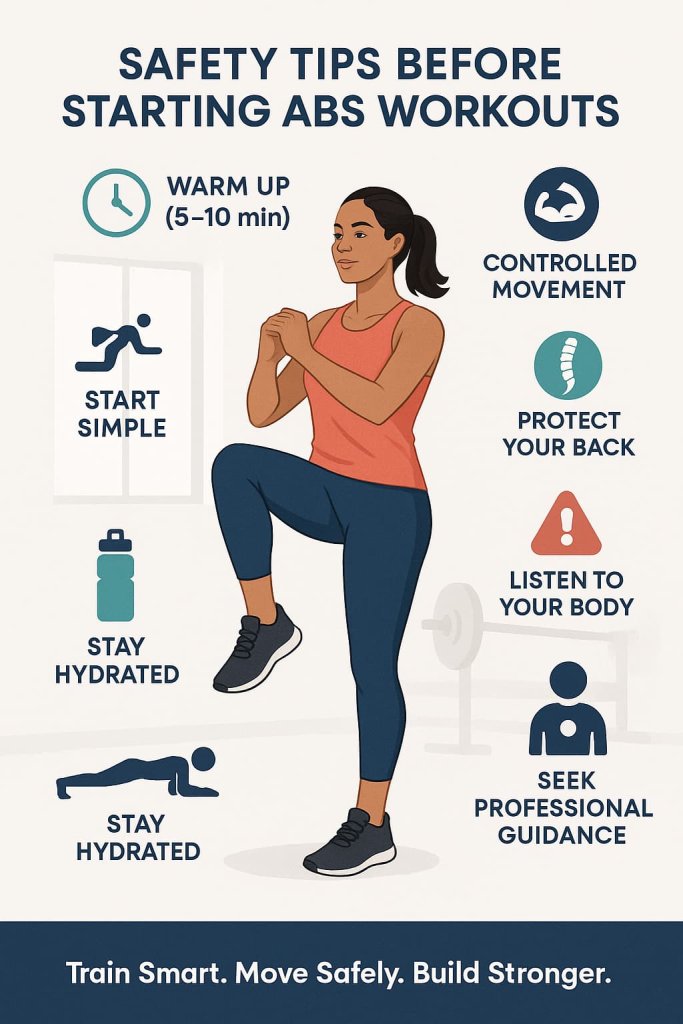The best abs workouts for women strengthen your entire core, not just your stomach — helping you achieve a flat, toned midsection while improving posture and stability.
A strong core is the foundation of all movement — from lifting groceries to running, yoga, and strength training. According to Harvard Health Publishing , core conditioning improves balance, protects your spine, and enhances athletic performance.

In this guide, you’ll discover 23 of the most effective ab workouts for women — from beginner to advanced — using both bodyweight and optional equipment. Each move targets a different area of your core for maximum definition and functional strength.
Why Core Training Matters for Women
Core training goes beyond aesthetics. Research from the Journal of Strength & Conditioning Research (2024) shows that consistent ab and trunk training improves stability, reduces back pain, and increases daily functional strength.

Benefits of strong abs for women include:
- Better posture and balance
- Flatter, more toned midsection
- Reduced risk of lower back pain
- Enhanced strength for daily tasks and workouts
- Improved sports performance
Your core isn’t just your abs — it includes your obliques, lower back, and deep transverse abdominis. Training all these muscles together creates a lean, sculpted, and strong midsection.
Safety Tips Before Starting Abs Workouts

- Warm up 5–10 minutes with light cardio and stretches.
- Focus on slow, controlled movements — not speed.
- Keep your back flat and abs engaged to prevent strain.
- Start with beginner moves like planks or bird dogs if new.
- Stop if you feel sharp pain or discomfort.
- Breathe steadily and stay hydrated.
- Consult a trainer or doctor if you have back or postpartum concerns.
23 Best Abs Workouts for Women
These 23 ab workouts target every layer of your core — from deep stabilizers to visible muscles — helping you build real strength and definition. Stay consistent, focus on form, and you’ll develop a leaner, stronger midsection that powers every movement.
1. Plank Hold
Why it works:
This foundational core exercise builds strength in your entire trunk — including deep stabilizers like the transverse abdominis — which supports your spine, improves posture, and enhances balance. Unlike crunches, the plank works your core isometrically, building endurance and stability essential for every movement.
Muscles worked:
Rectus abdominis, obliques, transverse abdominis, shoulders, glutes.
How to do it:
- Start face down on the floor with forearms under shoulders and elbows aligned.
- Extend your legs fully, balancing on your toes.
- Keep your body straight from head to heels, squeezing your core and glutes.
- Hold for 30–60 seconds, breathing steadily.
Trainer Tip:
Avoid letting hips drop or rise — think of creating a straight plank from head to heels. Keep your gaze down to maintain a neutral spine.
2. Side Plank
Why it works:
Side planks strengthen the obliques and hip stabilizers, helping to cinch the waist and improve overall balance. This unilateral exercise also corrects side-to-side strength imbalances often neglected by traditional ab routines.
Muscles worked:
Obliques, shoulders, glutes, quadratus lumborum.
How to do it:
- Lie on your side, elbow directly beneath your shoulder, feet stacked.
- Engage your abs and lift hips until your body forms a straight line.
- Hold 30–45 seconds per side.
Trainer Tip:
If you’re a beginner, keep the bottom knee on the floor for support. For added intensity, raise your top leg slightly during the hold.
3. Bicycle Crunch
Why it works:
One of the most effective ab exercises according to EMG studies, the bicycle crunch activates both the rectus abdominis and obliques through a combination of rotation and flexion — ideal for toning and tightening the midsection.
Muscles worked:
Rectus abdominis, external and internal obliques, hip flexors.
How to do it:
- Lie flat with hands lightly behind your head.
- Lift your shoulder blades off the mat.
- Bring one knee toward your chest while twisting the opposite elbow toward it.
- Alternate sides in a slow, controlled pedaling motion.
Trainer Tip:
Keep your lower back pressed into the mat. Move slowly to maximize muscle tension — not speed.
4. Glute Bridge March
Why it works:
A great hybrid move for your abs and glutes, this exercise enhances lower-body and core coordination. It targets your posterior chain while training pelvic stability — crucial for women who experience hip tightness or lower back strain.
Muscles worked:
Lower abs, glutes, hamstrings, hip stabilizers.
How to do it:
- Lie on your back, knees bent, feet flat on the floor.
- Lift hips so your body forms a straight line from shoulders to knees.
- While holding the bridge, alternate lifting one knee toward your chest.
Trainer Tip:
Avoid arching your back — keep ribs pulled down and abs braced to engage the deep core muscles.
5. Leg Raises
Why it works:
A classic lower-ab burner, leg raises strengthen the hip flexors and build deep core control. They help tighten the lower belly and improve pelvic stability — a key area for postpartum and desk-bound women.
Muscles worked:
Lower abs, hip flexors.
How to do it:
- Lie on your back with hands by your sides or under hips for support.
- Keeping legs straight, lift them slowly until perpendicular to the floor.
- Lower them back down without touching the ground.
Trainer Tip:
Focus on slow, controlled movement — lowering your legs is where most of the muscle engagement happens.
6. Flutter Kicks
Why it works:
This dynamic exercise improves muscular endurance and strengthens the lower abs while training the hip flexors. It’s great for toning the lower belly and increasing core stamina.
Muscles worked:
Lower abs, hip flexors, transverse abdominis.
How to do it:
- Lie on your back, legs extended, hands under hips.
- Lift both legs a few inches off the ground.
- Alternate small, quick up-and-down kicks.
Trainer Tip:
Maintain tension by keeping your core braced and back pressed flat into the mat.
7. Russian Twists
Why it works:
This rotational move sculpts the obliques and strengthens your transverse abdominis, improving your twisting power and waistline definition. It also enhances coordination between your upper and lower body.
Muscles worked:
Obliques, rectus abdominis, hip flexors.
How to do it:
- Sit with knees bent and feet slightly lifted.
- Lean back at a 45° angle.
- Rotate your torso side-to-side, touching the floor on each side.
Trainer Tip:
Hold a dumbbell or medicine ball to increase challenge, but keep your core engaged to prevent back strain.
8. Mountain Climbers
Why it works:
Combines cardio and core work — making it one of the best total-body ab exercises for fat burning and endurance. It improves coordination, agility, and dynamic core strength.
Muscles worked:
Core, shoulders, chest, legs.
How to do it:
- Start in a high plank with hands under shoulders.
- Drive one knee toward your chest, then quickly switch legs.
- Continue alternating like a running motion.
Trainer Tip:
Stay light on your toes and keep hips stable — avoid bouncing or arching.
9. Reverse Crunch
Why it works:
Targets lower abs effectively while reducing strain on the neck or spine, perfect for women who struggle with traditional crunches.
Muscles worked:
Lower abs, hip flexors.
How to do it:
- Lie on your back with knees bent at 90°.
- Lift hips off the mat, curling knees toward chest.
- Slowly lower back down under control.
Trainer Tip:
Exhale as you curl up and inhale as you lower — proper breathing enhances muscle activation.
10. V-Ups
Why it works:
A full-body ab exercise that challenges coordination, balance, and strength. It sculpts the entire midsection through simultaneous upper and lower body engagement.
Muscles worked:
Rectus abdominis, obliques, hip flexors.
How to do it:
- Lie flat, arms extended overhead.
- Lift arms and legs together to meet above your torso, forming a “V.”
- Lower back down with control.
Trainer Tip:
Keep your core tight throughout — avoid jerky movements or relying on momentum.
11. Standing Oblique Crunch
Why it works:
An upright alternative to floor crunches, this move trains your obliques and helps define the waistline while improving stability.
Muscles worked:
Obliques, rectus abdominis, hip flexors.
How to do it:
- Stand tall, hands behind your head.
- Lift one knee toward your elbow, crunching your torso to the side.
- Return and repeat on the other side.
Trainer Tip:
Keep your chest lifted and move with control — don’t lean forward or hunch.
12. Dead Bug
Why it works:
A highly effective exercise for strengthening the deep core and improving spinal stability. It retrains your abs to work in coordination with your hips — a must for functional movement.
Muscles worked:
Transverse abdominis, hip flexors, lower back.
How to do it:
- Lie on your back, arms and legs raised.
- Lower the opposite arm and leg simultaneously.
- Return to center and repeat on the other side.
Trainer Tip:
Keep your lower back pressed into the mat — if it lifts, reduce your range of motion.
13. Seated Knee Tucks
Why it works:
Strengthens the lower abs and improves coordination while being easy to perform anywhere — perfect for home workouts.
Muscles worked:
Lower abs, hip flexors.
How to do it:
- Sit slightly back, hands on the floor behind you.
- Draw knees toward your chest, then extend legs straight out.
- Keep your torso slightly leaned back.
Trainer Tip:
Stay slow and steady — pause briefly at the extension to maintain tension.
14. Bird Dog
Why it works:
Trains your core, glutes, and back to work together — improving balance, coordination, and lower back health. It’s great for posture correction.
Muscles worked:
Core, glutes, spinal erectors, shoulders.
How to do it:
- Start on all fours, hands under shoulders and knees under hips.
- Extend opposite arm and leg.
- Hold briefly, then return to start and switch.
Trainer Tip:
Keep your core tight and move slowly — this is a control-based move, not speed.
15. Hanging Leg Raise
Why it works:
A challenging lower-ab exercise that builds strength and control while improving grip and shoulder stability.
Muscles worked:
Lower abs, hip flexors, forearms.
How to do it:
- Hang from a pull-up bar with an overhand grip.
- Engage core and lift legs to hip height or higher.
- Lower slowly under control.
Trainer Tip:
Avoid swinging — focus on raising legs smoothly through core power.
16. Ab Wheel Rollout
Why it works:
Targets every layer of your abs — from surface to deep stabilizers — while improving shoulder and spinal control.
Muscles worked:
Rectus abdominis, transverse abdominis, shoulders, back.
How to do it:
- Kneel and grip an ab wheel in front of you.
- Roll forward slowly, extending your body without arching your back.
- Return to start by engaging your abs.
Trainer Tip:
Keep movements controlled and avoid collapsing your hips — the key is tension, not distance.
17. Toe Touches
Why it works:
Perfect for upper-ab definition, this move enhances flexion strength and tightens the midsection.
Muscles worked:
Upper abs.
How to do it:
- Lie on your back, legs extended upward.
- Reach hands toward your toes, crunching your upper abs.
- Lower slowly.
Trainer Tip:
Avoid pulling your neck — keep the motion small and controlled.
18. Heel Taps
Why it works:
Tones obliques and targets the muscles along your waistline, great for shaping the “hourglass” effect.
Muscles worked:
Obliques, rectus abdominis.
How to do it:
- Lie on your back, knees bent, arms at sides.
- Lift shoulders slightly and reach side-to-side to tap your heels.
Trainer Tip:
Keep core tight and avoid resting between reps — constant tension builds definition.
19. Weighted Sit-Up
Why it works:
Adds resistance to standard sit-ups, helping to build muscle density and core strength faster.
Muscles worked:
Upper abs, hip flexors.
How to do it:
- Hold a dumbbell or plate on your chest.
- Perform a sit-up, keeping feet anchored.
- Lower back down under control.
Trainer Tip:
Keep movement slow — resistance adds intensity, so don’t rush.
20. Standing Cable Rotation
Why it works:
A powerful core rotation exercise that mimics real-life athletic movement. It builds rotational strength and sculpts the obliques.
Muscles worked:
Obliques, transverse abdominis, lats.
How to do it:
- Set the cable handle at chest height.
- Stand sideways to the machine, arms extended.
- Rotate torso across your body, then slowly return.
Trainer Tip:
Don’t move your hips — isolate the twist through your core.
21. Stability Ball Pike
Why it works:
An advanced full-core exercise that builds deep strength, balance, and shoulder stability.
Muscles worked:
Abs, shoulders, lower back.
How to do it:
- Start in a plank with feet on a stability ball.
- Engage core and pull hips upward, rolling the ball toward you.
- Slowly return to start.
Trainer Tip:
Move with control — this should be smooth and deliberate, not fast.
22. Lying Windshield Wipers
Why it works:
Strengthens your obliques and lower abs through controlled rotation, helping to tighten and define your waist.
Muscles worked:
Obliques, lower abs, hip flexors.
How to do it:
- Lie flat, arms out for balance, legs extended upward.
- Slowly lower legs to one side, then the other.
Trainer Tip:
Keep shoulders anchored to the mat — the motion should come from your core.
23. Standing Resistance Band Crunch
Why it works:
A functional standing movement that replicates a cable crunch, ideal for home workouts without machines.
Muscles worked:
Rectus abdominis, obliques.
How to do it:
- Anchor a resistance band overhead.
- Grip handles and step back slightly.
- Crunch forward, contracting your abs as you pull down.
Trainer Tip:
Keep tension in the band throughout — your abs should initiate and control the movement.
How to Structure Your Abs Routine
For best results:
- Frequency: 3–4 sessions per week
- Sets & Reps: 3 sets of 12–15 reps (or 30–45 seconds per move)
- Rest: 30–45 seconds between exercises
- Progression: Add resistance or extend hold times every 2–3 weeks
Combine ab workouts with cardio and strength training to reduce body fat and reveal muscle definition.
Nutrition Tip for Visible Abs
Abs are made in the kitchen as much as in the gym. Maintain a moderate calorie deficit and eat protein-rich meals (1.6–2.2 g/kg body weight per day) to build lean muscle.
Include:
- Lean protein (chicken, tofu, eggs, fish)
- Complex carbs (oats, quinoa, vegetables)
- Healthy fats (olive oil, avocado, nuts)
- Adequate hydration
FAQs
1. Can women get abs without equipment?
Yes — bodyweight moves like planks, leg raises, and mountain climbers are highly effective.
2. How long does it take to see results?
Most women notice definition in 6–8 weeks with consistent training and clean nutrition.
3. Should I train abs every day?
No — 3–4 times a week is ideal. Muscles need recovery to grow stronger.
4. Are crunches bad for your back?
Not if done correctly. Keep your lower back supported and avoid jerking your neck.
5. What’s the best ab exercise for beginners?
Start with planks, dead bugs, and glute bridge marches for safe, full-core activation.
6. Do ab workouts burn belly fat directly?
Spot reduction isn’t possible. Combine ab training with cardio and a calorie deficit.
7. Should women lift weights for abs?
Yes — adding resistance builds visible definition and overall core strength.
Conclusion
Building sculpted, strong abs isn’t about endless crunches — it’s about smart, consistent training that targets every part of your core. Combine these 23 ab workouts with clean eating and full-body strength routines, and you’ll see a leaner, stronger midsection in weeks.
Start today — your strongest, most confident core is waiting.
References
- ACSM — Physical Activity Guidelines (Overview) — Evidence-based recommendations on warm-ups, progression, and safety.
- CDC (2024) — Benefits of Physical Activity — Health outcomes and safety context supporting regular exercise.
- ACOG — Exercise After Pregnancy (FAQ) — Postpartum return-to-exercise guidance, precautions, and timelines.
- NHS — Your post-pregnancy body (diastasis recti & core) — Practical advice on rebuilding core safely after childbirth.
